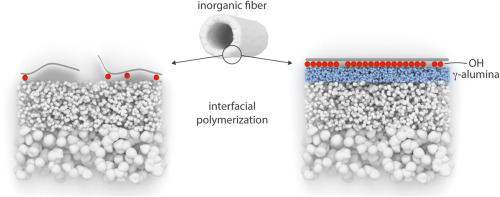当前位置:
X-MOL 学术
›
J. Membr. Sci.
›
论文详情
Our official English website, www.x-mol.net, welcomes your feedback! (Note: you will need to create a separate account there.)
Direct interfacial polymerization onto thin ceramic hollow fibers
Journal of Membrane Science ( IF 9.5 ) Pub Date : 2018-03-01 , DOI: 10.1016/j.memsci.2018.01.009 Evelien Maaskant , Patrick de Wit , Nieck E. Benes
Journal of Membrane Science ( IF 9.5 ) Pub Date : 2018-03-01 , DOI: 10.1016/j.memsci.2018.01.009 Evelien Maaskant , Patrick de Wit , Nieck E. Benes

|
Abstract Membrane separation under harsh conditions, such as high-p,T or in the presence of aggressive chemicals, requires a robust membrane support. In academia commonly ceramic disks are used for this purpose, but these disks posses a too low surface-area-to-volume ratio for practical applications. Ceramic hollow fibers potentially provide a much larger specific surface area, but applying a defect free thin selective layer on such structures is more intricate. Here we show the successful preparation of a thin polyamide layer on a thin porous hollow α -alumina fiber by interfacial polymerization of piperazine with trimesoyl chloride. Two aspects of the fabrication method are identified as particularly crucial for obtaining a high quality selective layer: i) the layer the ceramic surface should have a sufficient amount of hydroxyl groups for covalent attachment in order to avoid delamination, and ii) controlled drying steps are necessary to avoid local surplus or lack of liquid on the outer surface of the ceramic. To increase the hydroxyl group concentration, and to facilitate the presence of sufficient reactants in a large volume of small pores, the fibers have been coated with a layer of γ -alumina. Sufficiently long drying steps (20 mm) have been employed to avoid uneven drying over the length of the fiber. The obtained fibers show clean water fluxes in the range of 2–5 L m−2 h−1 bar−1 combined with a retention of Rose Bengal above 99%.
中文翻译:

直接界面聚合到细陶瓷中空纤维上
摘要 在苛刻条件下(例如高 p、T 或存在腐蚀性化学品)的膜分离需要坚固的膜支撑。在学术界,为此目的通常使用陶瓷盘,但这些盘的表面积与体积比对于实际应用来说太低了。陶瓷中空纤维可能提供更大的比表面积,但在此类结构上应用无缺陷的薄选择性层更为复杂。在这里,我们展示了通过哌嗪与均苯三甲酰氯的界面聚合在薄多孔空心 α-氧化铝纤维上成功制备薄聚酰胺层。制造方法的两个方面被认为对于获得高质量的选择层特别重要:i) 陶瓷表面的层应具有足够量的羟基用于共价连接以避免分层,以及 ii) 控制干燥步骤是必要的,以避免陶瓷外表面上的局部过剩或缺乏液体。为了增加羟基浓度,并促进在大量小孔中存在足够的反应物,纤维已涂有一层γ-氧化铝。已采用足够长的干燥步骤(20 毫米)来避免纤维长度上的不均匀干燥。所获得的纤维显示出 2–5 L m-2 h-1 bar-1 范围内的清洁水通量,同时孟加拉玫瑰的保留率超过 99%。ii) 控制干燥步骤是必要的,以避免陶瓷外表面上局部过剩或缺乏液体。为了增加羟基浓度,并促进在大量小孔中存在足够的反应物,纤维已涂有一层γ-氧化铝。已采用足够长的干燥步骤(20 毫米)来避免纤维长度上的不均匀干燥。所获得的纤维显示出 2–5 L m-2 h-1 bar-1 范围内的清洁水通量,同时孟加拉玫瑰的保留率超过 99%。ii) 控制干燥步骤是必要的,以避免陶瓷外表面上局部过剩或缺乏液体。为了增加羟基浓度,并促进在大量小孔中存在足够的反应物,纤维已涂有一层γ-氧化铝。已采用足够长的干燥步骤(20 毫米)来避免纤维长度上的不均匀干燥。所获得的纤维显示出 2–5 L m-2 h-1 bar-1 范围内的清洁水通量,同时孟加拉玫瑰的保留率超过 99%。已采用足够长的干燥步骤(20 毫米)来避免纤维长度上的不均匀干燥。所获得的纤维显示出 2–5 L m-2 h-1 bar-1 范围内的清洁水通量,同时孟加拉玫瑰的保留率超过 99%。已采用足够长的干燥步骤(20 毫米)来避免纤维长度上的不均匀干燥。所获得的纤维显示出 2–5 L m-2 h-1 bar-1 范围内的清洁水通量,同时孟加拉玫瑰的保留率超过 99%。
更新日期:2018-03-01
中文翻译:

直接界面聚合到细陶瓷中空纤维上
摘要 在苛刻条件下(例如高 p、T 或存在腐蚀性化学品)的膜分离需要坚固的膜支撑。在学术界,为此目的通常使用陶瓷盘,但这些盘的表面积与体积比对于实际应用来说太低了。陶瓷中空纤维可能提供更大的比表面积,但在此类结构上应用无缺陷的薄选择性层更为复杂。在这里,我们展示了通过哌嗪与均苯三甲酰氯的界面聚合在薄多孔空心 α-氧化铝纤维上成功制备薄聚酰胺层。制造方法的两个方面被认为对于获得高质量的选择层特别重要:i) 陶瓷表面的层应具有足够量的羟基用于共价连接以避免分层,以及 ii) 控制干燥步骤是必要的,以避免陶瓷外表面上的局部过剩或缺乏液体。为了增加羟基浓度,并促进在大量小孔中存在足够的反应物,纤维已涂有一层γ-氧化铝。已采用足够长的干燥步骤(20 毫米)来避免纤维长度上的不均匀干燥。所获得的纤维显示出 2–5 L m-2 h-1 bar-1 范围内的清洁水通量,同时孟加拉玫瑰的保留率超过 99%。ii) 控制干燥步骤是必要的,以避免陶瓷外表面上局部过剩或缺乏液体。为了增加羟基浓度,并促进在大量小孔中存在足够的反应物,纤维已涂有一层γ-氧化铝。已采用足够长的干燥步骤(20 毫米)来避免纤维长度上的不均匀干燥。所获得的纤维显示出 2–5 L m-2 h-1 bar-1 范围内的清洁水通量,同时孟加拉玫瑰的保留率超过 99%。ii) 控制干燥步骤是必要的,以避免陶瓷外表面上局部过剩或缺乏液体。为了增加羟基浓度,并促进在大量小孔中存在足够的反应物,纤维已涂有一层γ-氧化铝。已采用足够长的干燥步骤(20 毫米)来避免纤维长度上的不均匀干燥。所获得的纤维显示出 2–5 L m-2 h-1 bar-1 范围内的清洁水通量,同时孟加拉玫瑰的保留率超过 99%。已采用足够长的干燥步骤(20 毫米)来避免纤维长度上的不均匀干燥。所获得的纤维显示出 2–5 L m-2 h-1 bar-1 范围内的清洁水通量,同时孟加拉玫瑰的保留率超过 99%。已采用足够长的干燥步骤(20 毫米)来避免纤维长度上的不均匀干燥。所获得的纤维显示出 2–5 L m-2 h-1 bar-1 范围内的清洁水通量,同时孟加拉玫瑰的保留率超过 99%。



























 京公网安备 11010802027423号
京公网安备 11010802027423号